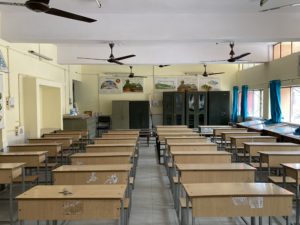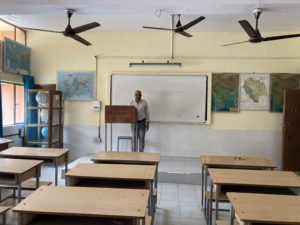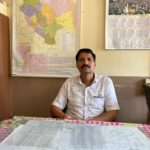Department of Geography
- About
- Faculty
- Syllabus
- PSO
- Subjects (COs)
- Infrastructure
- Achievements
- Activities
- Collaborations
- Time Table
Course Offered: BA (Geography)
At Govt Degree College Hamirpur, the course offered is BA(Geography) i.e. you will study History, Economics, Mathematics, Music, Public Administration and Sociology in this three year degree programme as your core subjects.
Departmental Profile of Geography
- Name of the department: Geography
- Year of Establishment: 1965
- Name of Programmes/Courses offered (UG, PG, M.Phil, PhD, Integrated Masters; Integrated Ph.D, etc.): UG (UG w.e.f. 1965)
- Name of Interdisciplinary courses and the departments/units involved: Generic Elective courses : BA III Year
- Annual/semester/choice based credit system (programme wise): UG CBCS Semester System (under R.U.S.A for the session 2017-18 and UG annual system w.e.f. 2018-19.
Numbers of Teaching Posts:
POST | Sanctioned | Filled |
|---|---|---|
Associate Professor/ Asstt. Professor | 02 | 02 |
Sr. No. | Name | Designation | Profile |
1. |
Dr. Vijay Thakur | Associate Professor | |
2. |
Sh. Rajinder | Assistant Professor |
Programme Specific Outcomes(PSOs):
PSO | Geography Specific Outcomes |
PSO1 | Students also learn the fundamentals of cartography, including how to make and read maps, scale maps, and how to handle data. They also learn about various ideas in geomorphology, climatology, and oceanography. |
PSO2 | Students learn about a variety of human geography topics, including human racial and ethnic groups, languages, and faiths, as well as the distribution of rural and urban settlements and the environment’s ecosystems, biomes, and environmental issues and policies. |
PSO3 | Students learn about several types of remote sensing, their benefits and applications, the definition of planning regions, and case studies including DVC and ITDP in particular. |
PSO4 | Students learn about India’s physiographic regions, its resource base, its climate, and its soils. Students learn about field methods, creating questionnaires, conducting field surveys, and writing field reports. |
PSO5 | Students learn about the many types of data structures, geographic information systems, and other GIS-related topics. |
PSO6 | Students learn about different sorts of disasters, how they are managed, and the fundamental ideas behind sustainability and development in a global perspective. |
The courses you will learn during this three year course is:
Course Outcomes (COs)
Sr. No. | Course Title | Course Code | Class | CO’s | Course Outcome |
1 | Physical Geography | GEOGP 101CC | B.A 1st Year | CO1 | Students are taught about the solar system’s introduction and hypotheses about the earth’s formation, such as the tidal hypothesis, the big bang theory, and rocks. |
CO2 | Davis introduces the ideas of the internal structure of the earth, plate tectonics, weathering, and the cycle of erosion to the students. | ||||
CO3 | Students gain knowledge of the atmospheric composition and structure, heat balance, pressure and wind systems, tropical cyclones, monsoons, and Koppen’s classification of climate. | ||||
CO4 | Students learn about oceans, tides, ocean currents, and Pacific Ocean Relief Features. | ||||
2 | General Cartography | GEOGP 102CC | B.A1st Year | CO1 | Students are familiar with the fundamental ideas behind map importance and classification. |
CO2 | Students learn about the meaning of several scales, including the plain, comparative, and diagonal scales. | ||||
CO3 | The foundation of creating maps is map projection. Students learn how to create different projections of maps, including conical, cylindrical, and zenith projections, as well as the necessity for and methods of map protection. | ||||
CO4 | Students are taught how to create a dot map and a choropleth map as well as how to show data using bar and line graphs. | ||||
3 | Human Geography | GEOGP 201CC | B.A 2nd Year | CO1 | Students learn the fundamentals of human geography, including its nature, scope, and applicability. |
CO2 | The patterns of population distribution around the world, as well as population growth and the theory of demographic transition, are familiar to the students. | ||||
CO3 | It imparts knowledge about the various human races and their geographic distribution. It is examined the distribution of the major world religions and languages. | ||||
CO4 | Students are taught about the definitions of rural and urban settlements, their historical development, their classification, and the patterns and trends in global distribution. | ||||
4 | Environmental Geography | GEOGP 202CC | B.A 2nd Year | CO1 | The significance of environmental geography and its application are explained to the students, along with its components. They learn about the ideas, elements, and functions of ecosystems. |
CO2 | They are educated about the interaction between humans and their environment using the ideas of environmentalism and possibility theory. | ||||
CO3 | The different types of pollution, including air, water, and pollution, are taught to students. pollution’s causes, effects, and management. Additionally taught are environmental issues and the loss of biodiversity. | ||||
CO4 | Students learn about the 1982 Environmental Protection Act. (2006) Indian environmental policy and the Chipko Movement. | ||||
5 | Regional Planning and Development | GEOGP 203 SEC | B.A 2nd Year | CO1 | The definitions of regions, regional planning, and regional development are introduced to the class. Regions’ characteristics and the definition of planning regions. |
CO2 | With the use of a case study on Himachal Pradesh (both physically and culturally), students learn about regionalization. | ||||
CO3 | The growth pole hypothesis and the core Periphery model are taught. | ||||
CO4 | Case studies of the DVC and the integrated tribal development programme (ITBP) are used to study regional development initiatives. | ||||
6 | Remote Sensing and GPS | GEOGP 204SEC | B.A 2nd Year | CO1 | Students learn about the definition, platforms, and several types of remote sensing. |
CO2 | They are given information about aerial photography, including its definition, types, principles, and geometry. | ||||
CO3 | Students learn about the fundamentals of satellite remote sensing, its meaning, and how it interacts with the earth’s surface and atmosphere. They also learn about Landsat and IRS satellites and sensors. | ||||
CO4 | Students learn about how to visually analyse satellite and aerial photography. Both the basics and applications of the Global Positioning System are covered. | ||||
7 | Geographic Information System | GEOGP 301 SEC | B.A 3rd Year | CO1 | Students learn about the definition of GIS, its use, its elements, and its history. |
CO2 | Students learn about vector and raster data structures as well as spatial and non-spatial data structures. | ||||
CO3 | Editing and the integration of attribute data are also covered in the georeferencing concept lesson. | ||||
CO4 | Students learn about thematic mapping, extraction of land use layers from any location, and georeferencing subsetting. | ||||
8 | Field Techniques and survey based project Report | GEOGP 302 SEC | B.A 3rd Year | CO1 | The purpose, importance, and ethics of fieldwork are taught. Field definition and case studies (rural/urban, physical/human environmental) are topics covered in class. |
CO2 | The teaching of field techniques, observation, participant and non-participant, as well as merits and demerits. | ||||
CO3 | Students learn about open-ended, closed-ended, structured, and non-structured questionnaires. Students learn about interviews with a particular emphasis on targeted group discussions. | ||||
CO4 | Students learn how to design a field report, including its goals and objectives, methodology, analysis, and writing. | ||||
9 | Geography of India | GEOGP 303 -IDSE | B.A 3rd Year | CO1 | Students learn about India’s primary physiographic areas. They become familiar with the ideas of the Indian climate and Indian soils. |
CO2 | Students learn about the increase in population since 1901 as well as concepts like population density distribution and sex ratio. | ||||
CO3 | Students learn about the many forms and patterns of urban and rural settlements. | ||||
CO4 | Students are taught information about agriculture, cotton textile industry, iron and steel industry, and power and mineral resources. | ||||
10 |
Disaster Management | GEOGP 304- IDSE | B.A 3rd Year | CO1 | Students learn about hazards, vulnerabilities, and many sorts of disasters. |
CO2 | Disasters like landslides, earthquakes, and cyclones that affect India are known. | ||||
CO3 | Students learn about human-caused calamities like road accidents and forest fires. | ||||
CO4 | Students are also taught NDMA, NIDM, community-based disaster management, and dos and don’ts during catastrophes in addition to response and mitigation to disasters. | ||||
11 | Disaster Risk Reduction | GEOGP 305 GEI | B.A 3rd Year | CO1 | Students learn about hazards, risks, and vulnerabilities. |
CO2 | It provides information on the causes, effects, and distribution of numerous sorts of disasters. There is also discussion of cyclones, floods, and earthquakes. | ||||
CO3 | Students learn about the causes, distribution, and mapping of human-induced disasters. | ||||
CO4 | Students are also taught NDMA, NIDM, community-based disaster management, and Dos and Don’ts during catastrophes in addition to response and mitigation to disasters. | ||||
12 | Sustainability and Development | GEOGP 306 GE2 | B.A 3rd Year | CO1 | Students learn about the ideas and elements of sustainability and development. |
CO2 | The Millennium Development Goals are explained, and national and international experiences are also covered. | ||||
CO3 | Students learn about the principles and elements of development and sustainability. | ||||
CO4 | National strategies and international experiences are also presented, along with information about the Millennium Development Goals. |


Students achievements
MoUs signed
Time Table 2023-24
Department of Geography
Name | 10:10-10:50 | 10:50-11:30 | 11:30-12:10 | 12:10-12:50 | 12:50-01:30 | 02:10-02:50 |
Dr Vijay Thakur | BA 2nd Remote Sensing & GPS SEC (1-2) (Room: Geography Lab) | BA 1st General Cartography (4-6) Room No: 164 | BA 2nd Environmental Geography (1-3) Room No: 162 | BA 3rd Field Survey and Report SEC (4-5) (Room: Geography Lab) | BA 3rd Geography of India (1-3) Room No: 63
| |
Prof. Rajinder Singh | BA 2nd Regional Planning & Dev SEC (3-4) (Room: Geography Lab) | BA 1st Physical Geography (1-3) Room No: 164 | BA 2nd Human Geography (4-6) Room No: 162 | BA 3rd GIS SEC (1-2) (Room: Geography Lab) | BA 3rd Disaster Management (4-6) Room No: 63 | |
Prof. Arun | BA 3rd Generic Elective (1-6) Room No: 162 |



